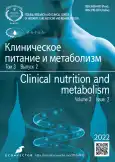Рossibilities of comprehensive correction of malnutrition in spinal cord injured patients
- 作者: Gumarova L.S.1, Bodrova R.A.1, Akhmetzianova G.Z.2
-
隶属关系:
- Kazan State Medical Academy — a branch of Russian Medical Academy of Continuing Professional Education
- Kazan State Medical University
- 期: 卷 3, 编号 2 (2022)
- 页面: 66-74
- 栏目: Original Study Articles
- URL: https://journals.rcsi.science/2658-4433/article/view/108613
- DOI: https://doi.org/10.17816/clinutr108613
- ID: 108613
如何引用文章
全文:
详细
BACKGROUND: Medical rehabilitation of spinal cord injured patients is an important medical and social problem associated with the high level of disability in this patient category.
AIM: This study aims to improve the efficiency of medical rehabilitation of spinal cord injured patients based on a set of measures of nutritional support and raising the exercise tolerance.
MATERIALS AND METHODS: A total of 78 patients in the intermediate recovery period of spinal cord injury were monitored, and their nutritional status was evaluated in the dynamics. In the first (main) group, a complex correction of the nutritional status with additional use of high protein hypercaloric mixtures for enteral nutrition was performed before and after hand cycling. In the second (control) group, the rehabilitation techniques were performed on the generally accepted basis.
RESULTS: As a result of the complex correction, the proportion of patients with mild and moderate malnutrition was significantly lower in the first (main) group than that in the second (control) group (p=0.05). Peak oxygen consumption increased in the first group of patients with mild malnutrition on 34.1% (p=0.019) and with moderate malnutrition on 23.6% (p=0.02) compared to that in the control group. All spinal cord injured patients of the first (main) group were found to have improved their motor and social activity according to the FIM scale compared to that in the control group (p <0.001).
CONCLUSIONS: Combining adequate nutritional support and proper handcycling significantly contributes to reducing malnutrition in patients with spinal cord injury (p=0.05). Tolerance to physical exercises during the complex correction of malnutrition significantly increased (p <0.01) as well as the motor and social activities and, therefore, the quality of life (p <0.0001).
作者简介
Lyaysyan Gumarova
Kazan State Medical Academy — a branch of Russian Medical Academy of Continuing Professional Education
编辑信件的主要联系方式.
Email: lyaisan@inbox.ru
ORCID iD: 0000-0002-5276-5107
SPIN 代码: 7624-4490
MD, Cand. Sci. (Med.)
俄罗斯联邦, KazanRezeda Bodrova
Kazan State Medical Academy — a branch of Russian Medical Academy of Continuing Professional Education
Email: bodrovarezeda@yandex.ru
ORCID iD: 0000-0003-3540-0162
SPIN 代码: 1201-5698
MD, Dr. Sci. (Med.), Associate Professor
俄罗斯联邦, KazanGulisa Akhmetzianova
Kazan State Medical University
Email: gulisa_ak@mail.ru
ORCID iD: 0000-0002-5743-8113
SPIN 代码: 2480-0868
MD, Cand. Sci. (Med.) Associate Professor
俄罗斯联邦, Kazan参考
- Gumarova LSh, Bodrova RA, Nazipova AYa, Busurgina EA. The principles of complex nutritional status disorder correction in patients with spinal cord injury. Bulletin of Contemporary Clinical Medicine. 2018;11(5):30–34. (In Russ). doi: 10.20969/VSKM.2018.11(5).30-34
- Furlan JC, Sakakibara BM, Miller WC, Krassioukov AV. Global incidence and prevalence of traumatic spinal cord injury. Can J Neurol Sci. 2013;40(4):456–464. doi: 10.1017/s0317167100014530
- Gumarova LSh, Bodrova RA. Assessment of need in nutritional support in patients with the consequences of central nervous system injuries. Zhurnal Nevrologii i Psikhiatrii imeni S.S. Korsakova. 2016;116(3):83–87. (In Russ). doi: 10.17116/jnevro20161163183-87
- Wong S, Graham A, Harini SP, et al. Profile and prevalence of malnutrition in children with spinal cord injuries-assessment of the Screening Tool for Assessment of Malnutrition in Paediatrics (STAMP). Spinal Cord. 2012;50(1):67–71. doi: 10.1038/sc.2011.139
- Noreau L, Martineau H, Roy L, Belzile M. Effects of a modified dance-based exercise on cardiorespiratory fitness, psychological state and health status of persons with rheumatoid arthritis. Am J Phys Med Rehabil. 1995;74(1):19–27. doi: 10.1097/00002060-199501000-00004
- Hjeltnes N, Aksnes AK, Birkeland KI, et al. Improved body composition after 8 wk of electrically stimulated leg cycling in tetraplegic patients. Am J Physiol. 1997;273(3 Pt 2):R1072–1079. doi: 10.1152/ajpregu.1997.273.3.R1072
- Figoni SF, Rodgers MM, Glaser RM, et al. Physiologic responses of paraplegics and quadriplegics to passive and active leg cycle ergometry. J Am Paraplegia Soc. 1990;13(3):33–39. doi: 10.1080/01952307.1990.11735814
- Haisma JA, van der Woude LH, Stam HJ, et al. Complications following spinal cord injury: occurrence and risk factors in a longitudinal study during and after inpatient rehabilitation. J Rehabil Med. 2007;39(5):393–398. doi: 10.2340/16501977-0067
- Hopman TE, Hughson R. Tilt induced changes in cardiovascular variables and sympathetic activity in spinal cord injured individuals. Med Sci Sports Exerc. 1998;25(5):577–583. doi: 10.1097/00005768-199805001-01807
- De Groot PC, Van Kuppevelt DH, Pons C, et al. Time course of arterial vascular adaptations to inactivity and paralyses in humans. Med Sci Sports Exerc. 2003;35(12):1977–1985. doi: 10.1249/01.MSS.0000099088.21547.67
- Hadley M. Hypermetabolism following head trauma: nutritional considerations. In: Barrow D., editor. Complications and Sequelae of Head Injury (Neurosurgical Topics series). Park Ridge, IL: AANS; 1992. P. 161–168.
- Krylov KYu, Savin IA, Goryachev AS, et al. Metabolic monitoring in patients in the acute period of severe traumatic brain injury. Bulletin of Anesthesiology and Resuscitation. 2012;9(6):29–33.
- Dhall SS, Hadley MN, Aarabi B, et al. Nutritional support after spinal cord injury. Neurosurgery. 2013;72(Suppl. 2):255–259. doi: 10.1227/NEU.0b013e31827728d9
- Hulsewé KW, van Acker BA, von Meyenfeldt MF, Soeters PB. Nutritional depletion and dietary manipulation: effects on the immune response. World J Surg. 1999;23(6):536–544. doi: 10.1007/pl00012344
- Cruse JM, Lewis RE, Roe DL, et al. Facilitation of immune function, healing of pressure ulcers, and nutritional status in spinal cord injury patients. Exp Mol Pathol. 2000;68(1):38–54. doi: 10.1006/exmp.1999.2292
- Cook AM, Peppard A, Magnuson B. Nutrition considerations in traumatic brain injury. Nutr Clin Pract. 2008–2009;23(6):608–620. doi: 10.1177/0884533608326060
补充文件







